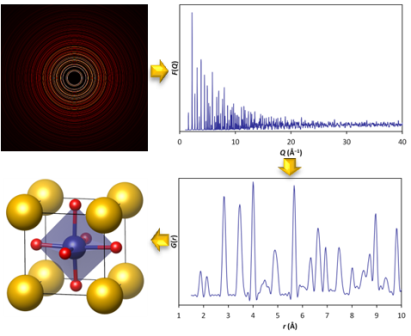Philip Chater is Principal Beamline Scientist, I15-1. Phil joined Diamond in August 2013 after working at the University of Birmingham and University of Liverpool.
Email: philip.chater@diamond.ac.ukTel: +44 (0) 1235 778677
Philip Chater is Principal Beamline Scientist, I15-1. Phil joined Diamond in August 2013 after working at the University of Birmingham and University of Liverpool.
Email: philip.chater@diamond.ac.uk
The local structure of many materials is often the key to understanding their properties. The pair distribution function (PDF) can be used to probe the structure of solids, amorphous materials and liquids on the local scale. The PDF is quantitative histogram of inter-atomic distances, and as such can be used for local structure refinement in much the same was as Bragg diffraction data are used for average structure refinement. The technique has wide applications in fields as diverse as battery and fuel cell materials, pharmaceuticals and the earth sciences.
The main theme underlying my research is in the determination of structures using powder diffraction techniques. Structure underlies many of the properties of any system, and so is a vial starting point for any system studied. I am particularly interested in materials for the energy economy, such as hydrogen storage materials, lithium ion conductors and fuel cell materials. The aim is to investigate short-range ion ordering these systems in order to understand their true local structure and gain an insight into their ion transport properties.
Other research activities include the development of fundamental parameter descriptions of 2-D area detectors for Rietveld analysis of powder diffraction data, developing tools for the rapid analsis of large datasets, and building new ways of Pair Distribution Function analysis.
XPDF (I15-1) has recently been upgraded to include a robotic sample changer and a new detector which is currently being commissioned. My team are in the process of optimising the beamline with the new detector to transform the speed and quality of PDF data possible at Diamond. My role is now to lead a team of excellent scientist to help PDF users to operate the beamline to get the best possible data for their science, as well looking for new developments and improvements to the beamline and performing my own research in the field of local structure analysis.
Useful presentations:
Phil obtained a MSci degree in Chemistry from the University of Birmingham (U.K.) in 2004. He continued at Birmingham researching under Dr Paul Anderson first for a PhD and then as a post-doc for the United Kingdom Sustainable Hydrogen Energy Consortium (UK-SHEC) researching complex hydrides for hydrogen storage and the link between reversibility and lithium ion conductivity.
In 2011 Phil joined the University of Liverpool (U.K.) as a post-doc working for Professor Matt Rosseinsky on the local structure of functional oxides, using X-ray and neutron Pair Distribution Function (PDF) analysis to study the short-range structure of materials. Structural characterisation from powders has been a theme underlying all of Phil's research; he has investigated a broad range of systems including complex hydrides, oxide ion conductors, metal organic frameworks, superconductors and ferroelectric materials. As Beamline Scientist at Diamond, Phil was resposible for setting up I15-1, the X-ray PDF beamline. Phil is now the Principal Beamline Scientist on I15-1 and leads an excellent team dedicated to the running and development of the beamline for rapid and robust production of high-quality X-ray PDF data.
Dr Lewis Owen, University of Sheffield
High temperature total scattering studies of metallic systems
PhD co-supervisor
Dr Hamish Yeung, University of Birmingham
Understanding hierarchical MOF assembly
PhD co-supervisor

S. A. Kondrat, P. J. Smith, P. P. Wells, P. A. Chater, J. H. Carter, D. J. Morgan, E. M. Fiordaliso, J. B. Wagner, T. E. Davies, L. Lu, J. K. Bartley, S. H. Taylor, M. S. Spencer, C. J. Kiely, G. J. Kelly, C. W. Park, M. J. Rosseinsky and G. J. Hutchings, "Stable amorphous georgeite as a precursor to a high-activity catalyst", Nature, 2016, 531, 83.
DOI: 10.1038/nature16935
J. P. Sutter, P. A. Chater, M. R. Hillman, D. S. Keeble, M. G. Tucker and H. Wilhelm, "Three-energy focusing Laue monochromator for the diamond light source x-ray pair distribution function beamline I15-1", AIP Conf. Proc., 2016, 1741, 040005.
DOI: 10.1063/1.4952877
E. F. Baxter, T. D. Bennett, A. B. Cairns, N. J. Brownbill, A. L. Goodwin, D. A. Keen, P. A. Chater, F. Blanc and A. K. Cheetham, "A comparison of the amorphization of zeolitic imidazolate frameworks (ZIFs) and aluminosilicate zeolites by ball-milling", Dalton Trans., 2016, 45, 4258.
DOI: 10.1039/C5DT03477A
A. A. Coelho, P. A. Chater and A. Kern, "Fast synthesis and refinement of the atomic pair distribution function", J. Appl. Cryst., 2015, 48, 869.
DOI: 10.1107/S1600576715007487
M. J. Cliffe, W. Wan, X. Zou, P. A. Chater, A. K. Kleppe, M. G. Tucker, H. Wilhelm, N. P. Funnell, F.-X. Coudert and A. L. Goodwin, "Correlated defect nanoregions in a metal–organic framework", Nat. Commun., 2014, 5, 4176.
DOI: 10.1038/ncomms5176
Diamond Light Source is the UK's national synchrotron science facility, located at the Harwell Science and Innovation Campus in Oxfordshire.
Copyright © 2022 Diamond Light Source
Diamond Light Source Ltd
Diamond House
Harwell Science & Innovation Campus
Didcot
Oxfordshire
OX11 0DE
Diamond Light Source® and the Diamond logo are registered trademarks of Diamond Light Source Ltd
Registered in England and Wales at Diamond House, Harwell Science and Innovation Campus, Didcot, Oxfordshire, OX11 0DE, United Kingdom. Company number: 4375679. VAT number: 287 461 957. Economic Operators Registration and Identification (EORI) number: GB287461957003.